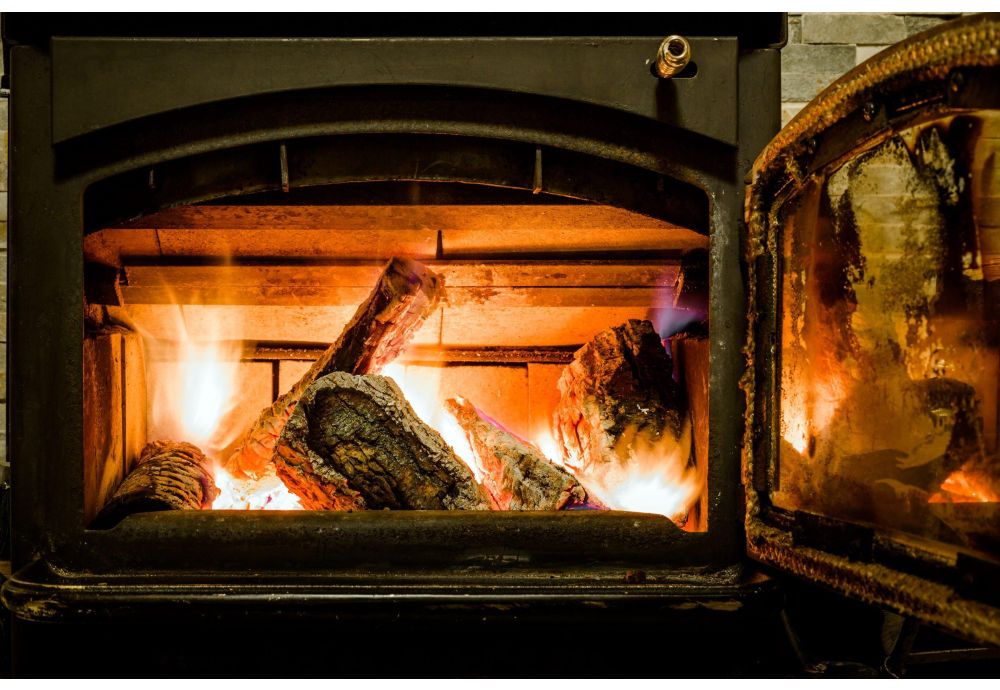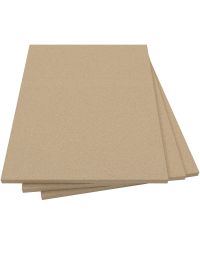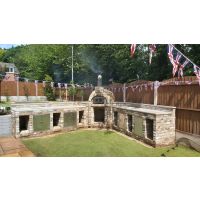Freestanding wood burning stoves add character to your house like no other fireplace. In traditional houses, wood stoves match the design perfectly; whereas in modern homes, they add the necessary rustic touch to any room.
When it comes to wood stoves, there are many things you may want to consider such as how to install a wood burning stove, how much the process of installing wood burning stoves cost or how to protect the surrounding area. This article will answer the considerations we deem the most important when installing a new stove.
How a wood burning stove works
Before we discuss freestanding stove installation, it is vital to explain what a wood burning stove is. The wood burning stove is essentially a heating appliance that makes use of burning wood as well as other fuels derived from wood such as wood pellets in order to provide heat for warming up a room or even cooking. Wood burning stoves are akin to wood burners and fall within the same category of stoves as a log burner or pellet stove. Unlike some other stoves and fireplaces, wood stoves (as well as the age-old log burner) are more eco-friendly due to their lower emissions and renewable fuel source.
Most commonly, the standard free standing wood burning stove comprises of a closed fire chamber that is created of a solid metal such as steel or cast iron, an adjustable control for air intake and out take, and a fire brick base.
In order to ensure proper ventilation, there are stove pipes (flues) which are connected to the chimney system and are used to remove the combustion gases that get filled up within the wood stove after the fire ignites within.
In order to make sure that the combustion gases are properly removed from the wood burner and released into the atmosphere on the outside, it must be ensured that the existing chimney be hotter than the external temperature. Now, all of the common wood burning stoves that exist generally come with an option of a grate, which allows users to use multiple fuels for heating, not limited to wood.
Log burners are an excellent alternative to a gas stove, they provide many advantages, such as:
- Ambiance: Log burners provide a cozy, real wood fire atmosphere.
- Sustainable Fuel: Wood is renewable and can be environmentally friendly when sourced responsibly.
- Independence from Utility: They operate without relying on gas lines.
- Energy Efficiency: Modern wood-burning stoves are highly efficient.
- Off-Grid Living: Ideal for remote or off-grid lifestyles.
- Potential for Lower Long-Term Costs: Can be more economical in areas with cheap wood.
- Backup Heating Source: They work even during power outages or gas disruptions.
- Carbon Neutrality: Burning wood is theoretically carbon neutral.
- Cooking Capabilities: Some models allow for cooking.
How to install a wood burning stove
The first thing to consider when you install a wood burning stove is where you locate it. You want to keep the wood stove at a safe distance from easily flammable materials such as furniture or the roof, especially in the event of any stray sparks flying out upon opening the stove door.
The next step is the log burner installation of a hearth on which you will place your wood stove. The hearth can be tiled or made from brick, granite, marble or slate. The purpose of the hearth is to shield the floor from the heat emanating from the stove and to safeguard the surrounding materials too. If your stove will be situated in a fireplace recess, make sure that you install a constructional hearth.
When you install your own stove, you should always ensure that the chimney flue is properly installed. There is a variety of the different kinds of chimney flues available on the market such as the twin wall flue (also referred to as a double, insulated ‘A’ class chimney). This differs from a single wall flue because a twin flue has an insulation layer, is fire resistant and can pass through combustible materials, namely through the roof and walls. In addition to this, it solves the dilemma of not having an existing chimney in the room where the wood burning stove is located.
Sometimes in the absence of a chimney or existing fireplace, you need to install a false chimney breast but for a freestanding wood stove, this is not necessary. You can always replace your existing gas fire or similar construction to make access to an existing chimney.
The chimney flue (pipe) heads straight upwards and allows the combustion gases to escape into the atmosphere. However, another chimney design is available where the pipe first goes through an external wall and then heads upwards. If the ceiling of your house is slanted, you will likely require a slanted chimney in order to get the air out into the outside atmosphere. Make sure that the entire length of the chimney flue is as long as can be, because the longer it is, the better performance it will provide. Also, make use of a flue closing/cap to ensure birds are not able to enter inside the chimney stack.
Other factors to consider may include the installation of a new lintel for the fireplace.
Installation of a freestanding stove in a fireplace recess
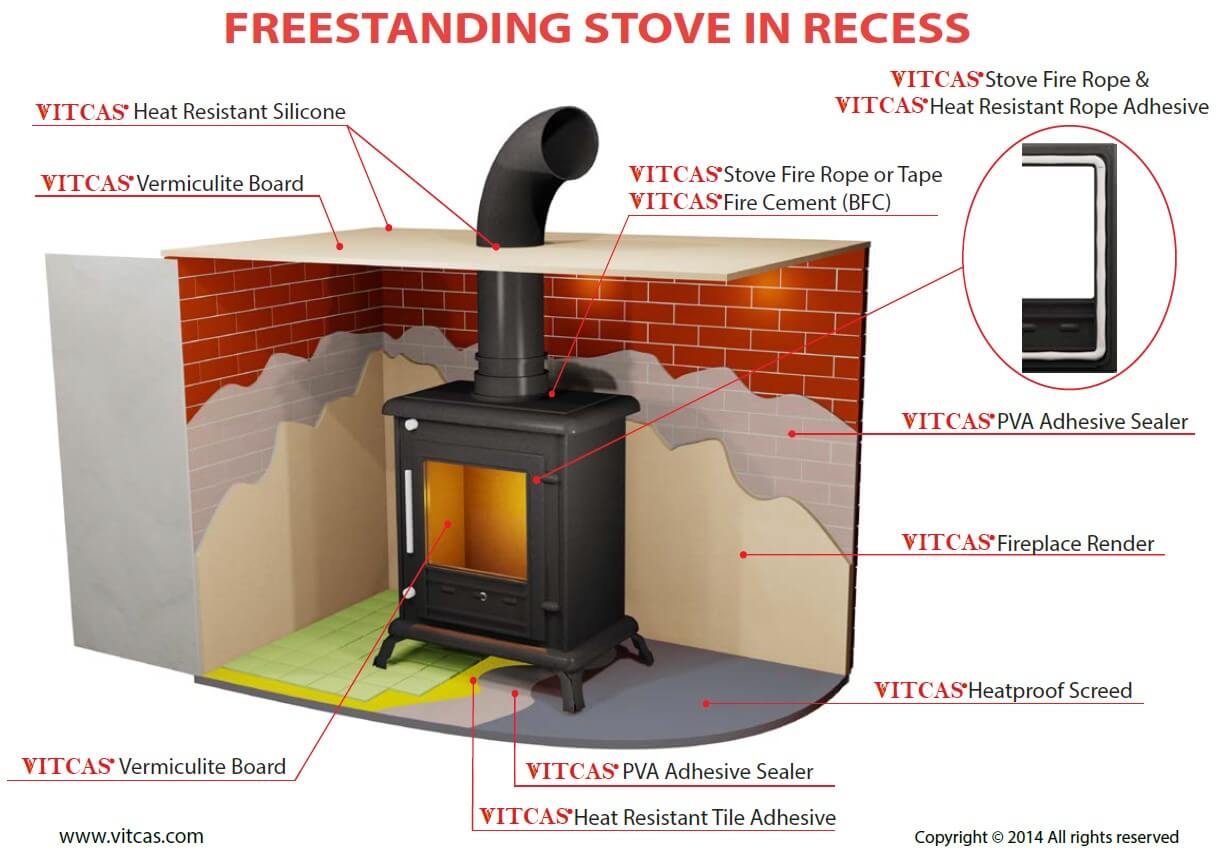
The installation process of a freestanding stove in the recess of a fireplace can be done by yourself without the need for professional help. However, make sure you comply with all regulations which are mentioned further in this article.
First, you need to first clean the area surrounding where the stove will go, so that it is free from contamination and ready to work on. Next, you must protect the surrounding area i.e. the walls and flooring and the register plate. Lastly, you want to consider the connection of the flue pipe for which you will need to tie rope around the pipe and apply Black Fire Cement on the first joint.
Protection of the floor and walls in a wood burner
For the most onerous portion of freestanding wood burning stove installation, there are two things you need to consider. Firstly, how to protect the floor underneath a wood burning stove and secondly, how to protect the walls around the wood stove. In order to protect the floor underneath your stove, installing a hearth is necessary. The hearth needs to be made from a non-flammable material like concrete, stone, brick or granite. You could also make use of fire bricks. Then on top of the surface, apply Heatproof Screed. If you wish to have a tiled surface on top, use our Tile Adhesive and Tile Grout for laying down and grouting around the tiles.
However for the walls, there is a different technique. First of all, make sure that the stove is placed at a safe distance from the walls. The distance between the stove and walls is prescribed by the manufacturer of the stove you have. Then install approved non-combustible material on the walls. There are three options you can go for: standard bricks with Fireplace Render, firebricks or use our Vermiculite Board. Alternatively, you could opt for the Heat Accumulation Board about which you can read more about in this article.
You must also install a rear heat shield at the back of the stove. For this purpose, you may use the Vermiculite Board. This will offer maximum protection to the surrounding area of your wood burning stove.
Lastly, you need to install the register plate and again, for this purpose you may use the Vermiculite Board as a register plate with Heat Resistant Silicone. Otherwise, you can use a register plate made from another non-combustible material such as cast iron or stainless steel.
Maintenance of a wood burning stove
When it comes to the maintenance of a wood stove, you will need to replace the rope seal around the stove door once a year. For this purpose, Vitcas offers a Stove Fire Rope and Rope Adhesive. For annual replacements, you can use the rope replacement kit which contains both the rope and adhesive. You can read our article on how to replace a stove rope seal here.
You will also need to keep your stove clean, for which we have the Stove Glass Cleaner for fireplace and stove doors and the Chimney Flue Cleaner for cleaning your chimneys and flues.
Installation and maintenance of a wood stove against-the-wall
For the installation of this type of free standing stove, the same products and instructions apply as for installing the stove in recess. However, since the stove will be against the walls, make sure that they are well insulated with Vermiculite Board or Fireplace Construction Board. Also there is no need for a register plate with this type of wood stove.
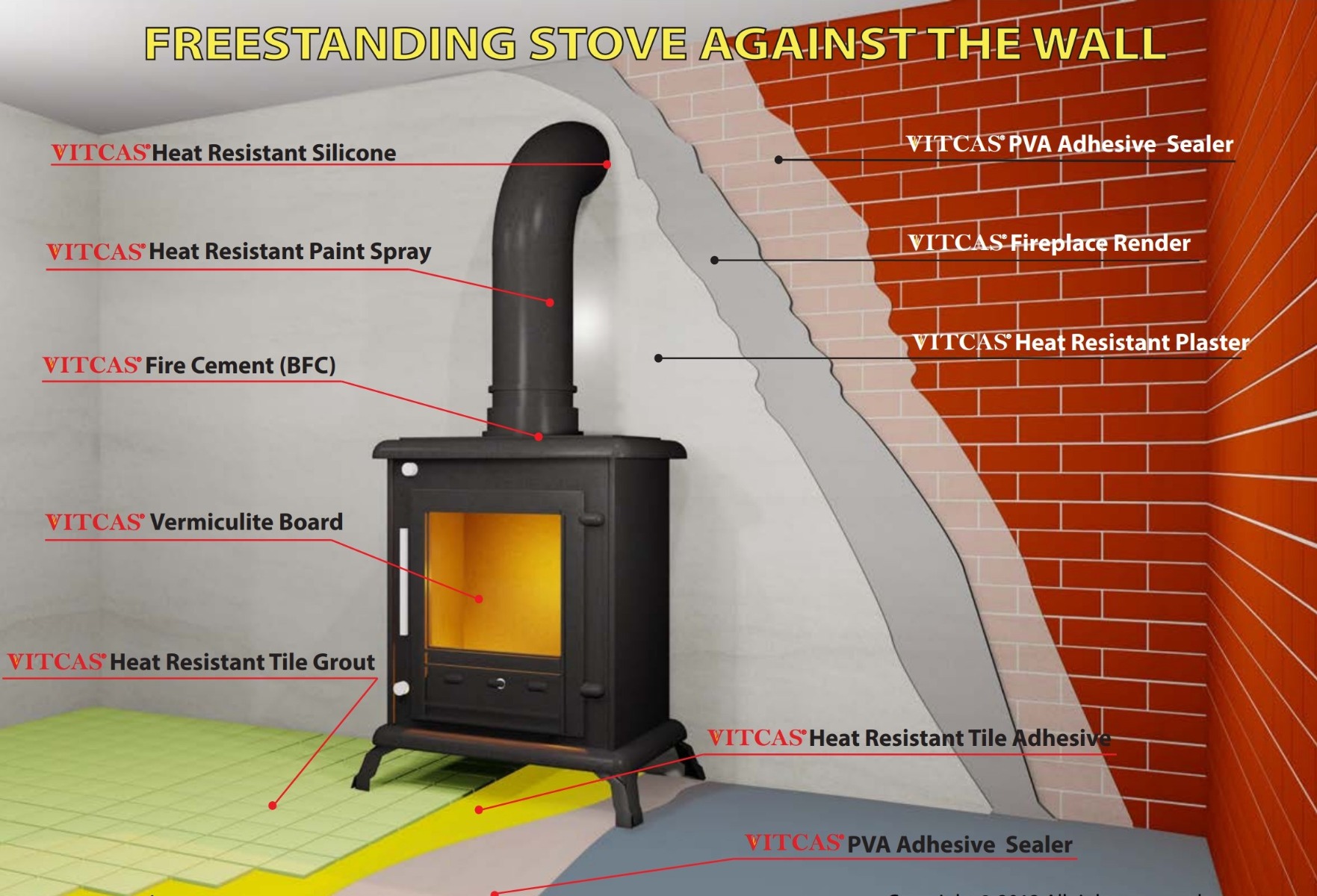
Electric stoves
When installing a new stove, you can always opt for an alternative to the traditional wood burning stove or log burning stove. One example is the electric stove which is less time consuming when you need to quickly heat the house, in contrast to the wood burning stove which requires wood to burn. However, just because it is more convenient in that regard does not necessarily mean the electric stove is more cost effective.
Safety considerations for wood burning stoves
You need to always be mindful of any existing safety regulations. Most importantly, building regulations require that a HETAS registered engineer needs to verify that the wood stove and chimney flue have been installed correctly. They can even offer professional help in the installation of the wood burning stove or chimney.
Secondly, building regulations require a chimney liner to be installed in the chimney system of almost every wood burner and log burner. A chimney liner (also referred to as a flue liner) is important because it keeps all the toxic gases and carbon monoxide contained inside the chimney flue and instead directs them outside of the home. This not only prevents inhabitants from inhaling any toxic gases, but also prevents a fire from starting. We would recommend opting for a stainless steel liner, but a ceramic and concrete liner would work well too. When you install a chimney flue liner, keep in mind that you may need a cherry picker to reach it if it is too high.
If you do have a stainless steel liner, you do not need to also install a register plate.
Another option to tackle this issue is by having carbon monoxide alarms installed. Such a carbon monoxide detector can detect when its levels are too high and give you sufficient warning so you can act accordingly.
Another important point is to always keep the door closed to ensure optimal safety.
Conclusion
These are the main recommendations of factors to consider when beginning the process of freestanding wood burning stove installation. Most importantly, make sure you comply with the necessary regulations to ensure your safety and the safety of your household.
All mentioned materials for stoves and fireplaces you can find in our shop.









